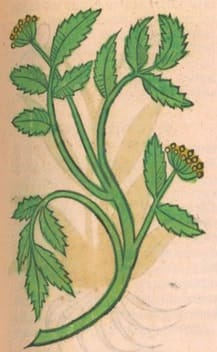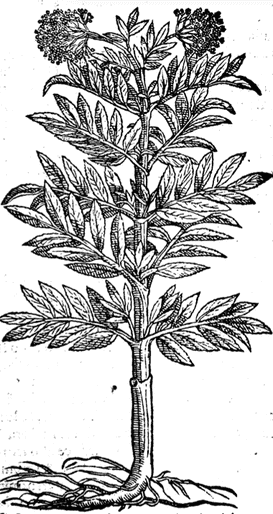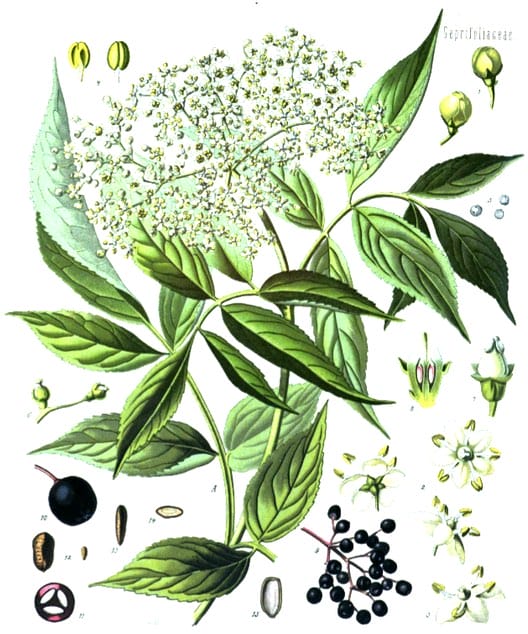Sambucus Fructus, Elder Berry
 Ortus Sanitatis, Meydenbach, 1491
Ortus Sanitatis, Meydenbach, 1491

|

|
|
Della Materia Medicinale, Andrea Valuassori, 1562 |
‘Common’ and ‘Jagged’ Elder Parkinson, Theatrum Botanicum, 1640 |
 Koehler’s Medizinal Pflanzen, 1887
Koehler’s Medizinal Pflanzen, 1887Botanical name:
Sambucus nigra
Parts used:
Fruit; also the Seed
Temperature & Taste:
Cool, Moist, Sweet, Sour
Classifications:
3C. ALEXIPHARMIC
Uses:
1. Clears Wind and Damp, Eases Pain, Promotes Urine:
-Edema, difficulty Urinating, Gravel and Stones.
-Arthritis, Rheumatism; Elder seeds were also used
-proven effective in Sciatica (Vetlesen, Norske Magazine for Laege Videnskaben, 1916)
-proven very effective in Neuralgia, Trigeminal Neuralgia (Epstein & Jokel, Prague Med. Wschr., 1914)
2. Clears Phlegm, Stops Cough and Wheezing:
-Wine of Elder berries has been used for Asthma, especially when a little Cinnamon is added.
-Throat pain
3. Clears Phlegm, Resolves Swellings:
-Phlegm swellings including Scrofula, swollen Glands and Nodes.
–‘Conserve of Elder berries does also cure all inward swellings’. (Wirtzung)
4. Moves the Bowels:
-Syrup of the Fruit is used as a mild Laxative
5. Tonic:
-‘An extract composed of the berries greatly assists longevity’. (John Evelyn)
6. Externally:
–juice or other preparations of the berries were much used as a folk remedy for burns and scalds in some parts; also for various skin diseases
-berry juice is applied to Warts (Culpeper)
-Eye diseases; it has been credited with restoring sight to the blind in some cases (esp. berries, both internally and externally).
-juice of the Berries boiled with honey is dropped into ears for for earache.
-fresh berries crushed and applied relieves Arthritic pain (Herbarium Horstianum, 1630)
Dose:
Powder: 1½–4 grams
Decoction: 3–6 grams
Juice of Berries: 1–2 tablespoonfuls;
Seed in Powder: 1–4 grams, powdered and taken with wine;
Preparation:
The seed was steeped in Vinegar, then dried for use.
Comment:
1. Schroder relays the story of Dr. Martin Bolchwizt, who, in his Anatomy of the Elder, said the Elder could be used to cure most diseases. This has been carried on today where it is often said ‘the Elder is a medicine chest in itself’.
2. All parts have an ‘opening’ (purgative) effect. The Leaf and Flower are mildest in function, and principally promote Sweat. Next the Berries which are best to promote Urine; the Bark or Root bark is more powerful being laxative, and in full doses the inner bark is a hydragogue cathartic.
3. For some indications, different authors used different parts for the same purposes, especially to promote Urine which can be treated by any part of the plant.
4. In Summary:
i. Flowers are principally Diaphoretic, used in acute diseases and Fevers, as well as Cough, Bronchitis, Sore Throat, Asthma and Wheezing
ii. Juice, Tincture or Infusion of the Flowers are sedative and relieve pain
iii. Leaf in general can be used as the Flower, but is stronger to promote Urine.
iv. Berries promote Urine, are slightly tonic, and also resolve Swellings.
v. Bark and Root bark are Diuretic in Edema and Urinary disorders, and Arthritic disorders. Full doses are Cathartic
Main Combinations:
1. Rheumatism, Elder berry and Willow bark
Major Formulas:
SEED:
Powder for Arthritis of Turner
Cautions:
1. Berries and Flowers are generally Safe.
Main Preparations used:
Rob (pulp of the Ripe berries), Tincture, Spirit
1. Spirit of Elder berry:
i. bruise Elder berries, leave to ferment in a barrel until they have a vinous odor; distil slowly. (Dispensatorium Pharmaceuticum, 1777)
-
Extra Info
-
History
|
‘There are two kinds of elder, one of which grows wild and is much smaller than the other; by the Greeks it is known as the “chamaeacte,” or “helion.” A decoction of the leaves, seed, or root of either kind, taken in doses of two cyathi, in old wine, though bad for the upper regions of the stomach, carries off all aqueous humours by stool. This decoction is very cooling too for inflammations, those attendant upon recent burns in particular. A poultice is made also of the more tender leaves, mixed with polenta, for bites inflicted by dogs. The juice of the elder, used as a fomentation, reduces abscesses of the brain, and more particularly of the membrane which envelopes that organ. The berries, which have not so powerful an action as the other parts of the tree, stain the hair. Taken in doses of one acetabulum, in drink, they are diuretic. The softer leaves are eaten with oil and salt, to carry off pituitous and bilious secretions. |
‘The smaller kind is for all these purposes the more efficacious of the two. A decoction of the root in wine, taken in doses of two cyathi, brings away the water in dropsy, and acts emolliently upon the uterus : the same effects are produced also by a sitting-bath made of a decoction of the leaves. The tender shoots of the cultivated kind, boiled in a saucepan and eaten as food, have a purgative effect : the leaves taken in wine, neutralize the venom of serpents. An application of the young shoots, mixed with he-goat suet, is remarkably good for gout; and if they are macerated in water, the infusion will destroy fleas. If a decoction of the leaves is sprinkled about a place, it will exterminate flies. “Boa” is the name given to a malady which appears in the form of red pimples upon the body; for its cure the patient is scourged with a branch of elder. The inner bark, pounded and taken with white wine, relaxes the bowels.’ (The Natural History of Pliny, trans. by Bostock and Riley, Vol. 5, 1856) |
